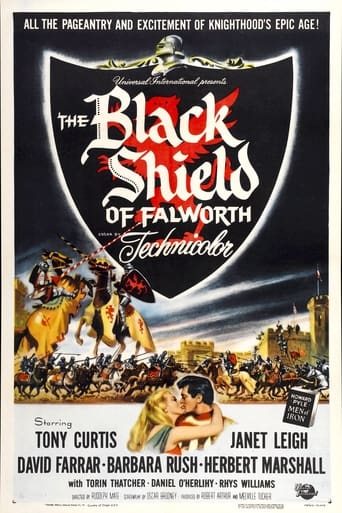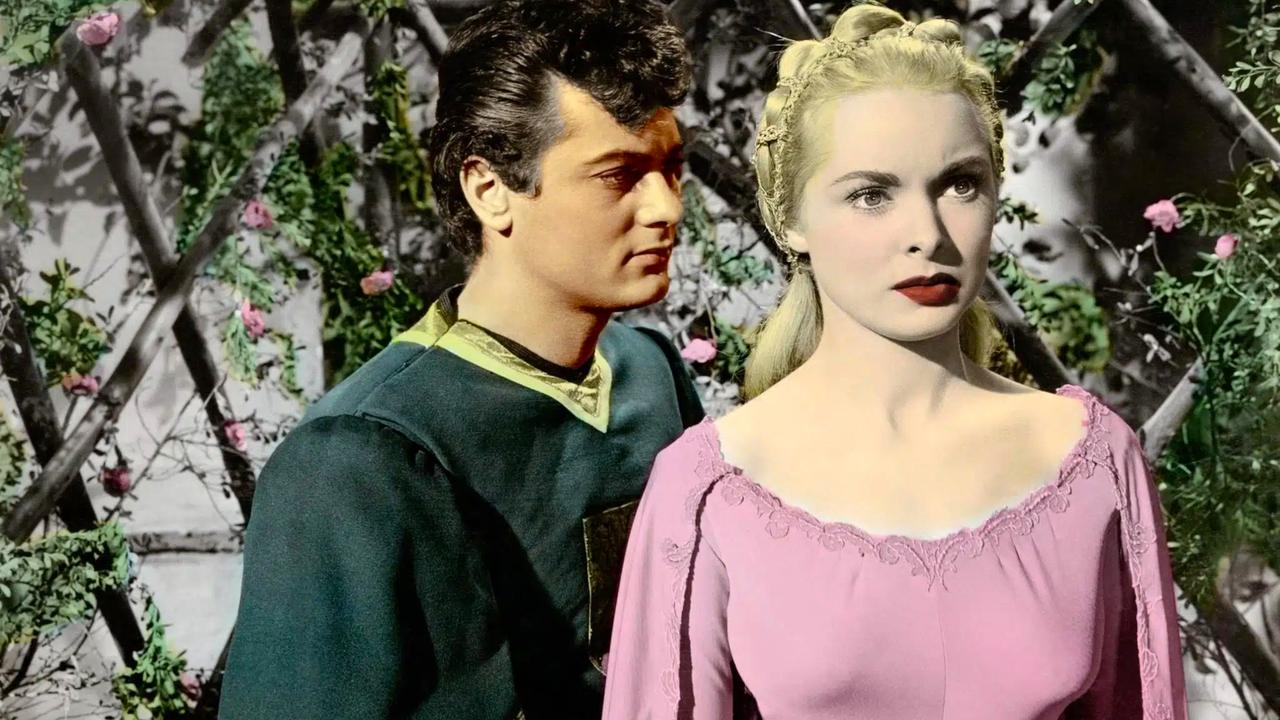weezeralfalfa
This is a tale of intrigue and the training of squires and knights in the early 14th century, during the reign of Henry IV of England. Tony Curtis plays the lead role, as Myles, beginning as a simple peasant, unsure of his parentage, living with his eligible sister Meg (Barbara Rush), and another man: Driccon. They suffer an attack by a group of men, apparently looking to force Tony to become a soldier. Also, one tries to rape Meg. This incites Tony into a frenzy of gymnastic moves that subdues the whole bunch, then steals a horse and rides to the sanctuary of a church, with caretaker Friar Edward. Meg and Diccon somehow soon join Tony. The friar recommends that they journey to the castle of the Earl of Mackworth, who hopefully will offer protection, and a chance for Tony to learn to become a squire. This they do, not being welcomed enthusiastically in the absence of the earl. They are subject to cat calls relating to their status as peasants, and Tony eventually starts a brawl, in which he again demonstrates his ability to combat a group of men without any conventional weapons. He learns about the Book of Heraldry in the earl's forbidden library, and that it contains a list of the coat of arms for all the noble families. He wants to look through it for his possible family, and is caught sneaking into the library, receiving a punishment. He has another brawl with some of the squires in training, especially Walter Blunt, brother? of the Earl of Alban.(Just why Walter is training in Mackworth's castle rather than his brother's castle is not explained). Tony begins the training to become a squire, which consists mostly of discipline and sword fighting with or without a shield, taught by Sir James. It appears he is actually being trained to be a foot soldier or guard rather than an aid to a knight, which was my idea of what squires did. The earl recommended that Tony be trained as a knight, since he was advancing faster than the other squire candidates. He had to get used to carrying the 70 lb. weight of his suit of armor, and how to handle his horse as well as a sword and shield. Lady Anne(Jane Leigh) the earl's daughter, took a liking to Tony, but was forbidden to interact with him, as he was of peasant stock and she was promised to squire-in-training Walter Blunt. Nonetheless, they sneaked in rendezvous in the courtyard that cemented their romantic attraction. Eventually, they are caught, and Tony's 'punishment' is to joust with the visiting jousting champion from Burgundy: Count Vermois. But this is scratched when Walter Blunt claims Tony has to go to the dungeon and await his hanging the next day! But, arguments before King Henry, who was visiting Mackworth, finally convinced him that Tony was due a trial by combat(jousting)with the Earl of Alban. Many things rode on the outcome of this joust. Not only Tony's life, but his claim to the castle of Alban and surrounding lands, which had previously belonged to the Falworths, and the question of the guilt of the Falworth clan as traitors, plus the prospect of Lady Anne as his bride. As things turned out, the outcome of their joust was interrupted by a general brawl between the men of the 2 castles, occasioned by an attempted assassination of King Henry, looking on. Tony and the Earl continued their contest on foot among the brawlers. If interested, the screenplay for this film was adapted from the novel "Men of Iron". A list of some of the differences between the book and film are listed at Wikipedia. I include some of these. In general, I would say the screenplay sounds like it's more exciting. 1)Myles' parents were still alive at the beginning 2)Myles' lacks a sister 3)Francis Gascoyne(Myles' friend) has no sweetheart(Meg being absent) 4)Meles' great enemy(Earl of Alban) is not revealed until near the end 5)Walter Blunt is not the Earl of Alban's brother and he disappears part way through. 6)Walter Blunt is not a suitor for Lady Anne 7)The Earl of Alban doesn't try to seize the throne from Henry 8)King Henry isn't as pleased by Myles' victory over the Earl of Alban. 9)Full restitution of the Falworths wouldn't occur until Henry V took the throne.There is an excellent copy at YouTube
James Hitchcock
There are two sorts of people, those who believe that Humphrey Bogart says "Play it again, Sam" in "Casablanca", and those who realise that he never uses those exact words in the film. They are, however, not so very different to what he actually does say, but "The Black Shield of Falworth" has become the centre of an even more curious misconception. There is a widespread belief that in it Tony Curtis utters the line "Yonda lies da castle of my fodda", but in fact he never says these words or anything like them, and the castle of his father never features in the film.I think that this misconception has arisen because many critics, mostly British, feel that there is something inappropriate in Hollywood making films about "our" history, and something particularly inappropriate about casting an American actor, especially a Hungarian-American New Yorker with a working-class accent, as a fifteenth-century English nobleman. Now it is certainly true that people in fifteenth-century England did not speak with twentieth-century American accents. On the other hand, they did not speak with twentieth-century British accents either. The only linguistically accurate way of making a film like this one would be to translate all the dialogue into Chaucerian English and to coach the actors in the correct way to pronounce it, a process which would render the film largely incomprehensible to anyone unfamiliar with Middle English. Moreover, although Curtis's character Myles Falworth is an aristocrat by birth, he has been brought up among the peasantry and would have spoken a rustic working-class dialect, even more incomprehensible to modern ears than the courtly, literary language of the middle-class Londoner Chaucer.When the film begins, Myles is to all intents and purposes a young peasant living on a farm in with his adoptive father Diccon Bowman and his sister Meg. One day he intervenes to prevent Meg from being molested by a band of noblemen. Realising that Myles has put his life in danger by his rash intervention, Diccon sends Myles and Meg to live at the castle of the Earl of Mackworth, where Myles is trained as a man-at-arms. The Earl is a close friend of the heir to the throne, the future Henry V, and Myles finds himself caught up in a treasonable political intrigue. Myles needs to foil this plot and to discover the truth about his real father, a mystery to which the "black shield" of the title may provide a clue.For all the controversy about Curtis's accent, this is actually a pretty good film. The handsome, athletic Curtis makes a dashing action hero in the tradition of Errol Flynn and Burt Lancaster, and other good contributions come from David Farrar as his antagonist, the villainous Earl of Alban, and Janet Leigh as his love-interest, Mackworth's daughter Lady Anne. (This was the second of five films which Curtis and Leigh, then husband and wife, made together). One performance which particularly stands out is that of Torin Thatcher as the one-eyed Sir James, the mediaeval equivalent of a strict-but-fair sergeant major, who tutors Myles in the arts of war.The film is visually attractive, being shot in a vivid Technicolor appropriate to the era in which it is set. The Middle Ages were a period which loved bright colours and display; pre-Reformation churches, for example, were often brilliantly- even by modern standards gaudily- painted. Another attractive feature is Hans Salter's stirring musical score. Although the screenplay was adapted from a late Victorian novel, Howard Pyle's "Men of Iron", it has something of the feel of a mediaeval romance, and not only in its straightforward good-versus-evil morality. Several of the Arthurian legends, such as the Tale of Sir Gareth, tell of an obscure young man who turns out to be not only of noble blood but also a knight of great prowess. There may be a couple of factual errors, but one feels that in its spirit "The Black Shield of Falworth" is true to its period. 7/10 A goof. We are told that Myles's father was unjustly condemned by King Henry "fifteen years ago"; Henry IV, in fact, reigned for less than fourteen years. (September 1399 to March 1413). Some may claim as a goof the fact that the design of the Falworth family coat-of-arms, a red griffin on a black shield, violates the heraldic Rule of Tincture, which states that only the "metals" gold and silver may appear against a background of a "colour" such as black or red. This may, however, not be a goof as there are certain coats-of-arms, albeit only a small proportion of the total number, which do not comply with the Rule.
ianlouisiana
Tony Curtis...how I wanted to be him back in 1956.The hair,the voice,the athleticism and grace....and married to Janet Leigh,it must have been just about the perfect life.I saw him on "The One Show" on BBC last month and he still looks better than me,still has the ladies swooning,and he's in a wheelchair for heaven's sake.Go figure. Unfairly denigrated and ignored for nearly half a century,"The black shield of Falworth"is just getting the recognition it deserves as a near perfect example of the Hollywood technicolor costume picture. It has no pretensions to historical accuracy,not a huge use is made of the iambic pentameter,the general filth and casual cruelty and violence of the Middle Ages is nowhere to be seen.This is Henry IVth's England as it never was,presented to ordinary 20th century audiences as a world of gentle knights with perfect teeth,dimpled maidens and big bad barons. It's entertainment,not a history lesson.And very successful entertainment too. Mr T.Curtis is outstanding as the young Falworth.Fizzing with suppressed energy,he tears into the part like a young puppy with a new toy.As a dispossessed heir,it is a role not unlike the one he would later play in the mighty "The Vikings".Mr T.Thatcher(no relation) gives his customary all as his mentor.Miss Leigh is charming and demure,Mr O' Herlihy a bluff Prince Hal. This picture is best viewed from behind a stick of candy floss,having just finished your "Kia Ora" and prior to daring to sneak your hand into your girl friend's.As your heart beats louder in your chest you can think that maybe you wouldn't want to swap places with Tony Curtis after all.
LRonCupboard
Written as a document the "pink casting couch" phenomenon of the 1950's this movie sees a lot of well turned out lads with greaser haircuts being groomed for knighthood (starring roles) by a lot of Ado-masochistic old men (producers/directors) while being warned away from women. Amazingly this movie got past the Hollywood brass and the censors to become a minor hit which is a testament to Rudolph Mate, a lifelong celibate and dog-handler. Much rambunctious dorm tomfoolery ensues between these little honeys. Critics pan Tony Curtis for his Medieval English accent and at the time some of these critics were old enough to remember the era so their words may ring true. Janet Leigh looks like a pint of milk rubbed with lipstick which may be intentional.


 AD
AD




